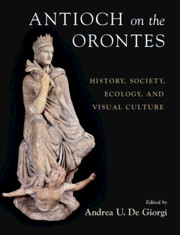Book contents
- Antioch on the Orontes
- Antioch on the Orontes
- Copyright page
- Dedication
- Contents
- Plates
- Figures
- Tables
- Contributors
- Abbreviations
- Antioch on the Orontes
- Part I Beginnings
- Part II The Making of a Capital
- Chapter 8 Antioch as a Provincial Capital
- Chapter 9 Building Programs and Natural Disasters
- Chapter 10 The City Walls of Antioch
- Chapter 11 Powerful Springs and Dangerous Torrents on Unsafe Ground
- Chapter 12 Housing in Daphne
- Chapter 13 The Antioch Mosaics
- Chapter 14 Coinage of and in Antioch in the Late Antique and Early Byzantine Periods
- Part III The People of Antioch
- Part IV Religion
- Part V Crises and Resilience
- Index
- Plate Section
- References
Chapter 10 - The City Walls of Antioch
How Many?
from Part II - The Making of a Capital
Published online by Cambridge University Press: aN Invalid Date NaN
- Antioch on the Orontes
- Antioch on the Orontes
- Copyright page
- Dedication
- Contents
- Plates
- Figures
- Tables
- Contributors
- Abbreviations
- Antioch on the Orontes
- Part I Beginnings
- Part II The Making of a Capital
- Chapter 8 Antioch as a Provincial Capital
- Chapter 9 Building Programs and Natural Disasters
- Chapter 10 The City Walls of Antioch
- Chapter 11 Powerful Springs and Dangerous Torrents on Unsafe Ground
- Chapter 12 Housing in Daphne
- Chapter 13 The Antioch Mosaics
- Chapter 14 Coinage of and in Antioch in the Late Antique and Early Byzantine Periods
- Part III The People of Antioch
- Part IV Religion
- Part V Crises and Resilience
- Index
- Plate Section
- References
Summary
The walls of Antioch are the only visible memento of the ancient city. Continuously repaired and reconfigured, they encompass at least eight different phases. How these defenses document the transformation of the city through the ages is the core issue.
Keywords
- Type
- Chapter
- Information
- Antioch on the OrontesHistory, Society, Ecology, and Visual Culture, pp. 139 - 163Publisher: Cambridge University PressPrint publication year: 2024



